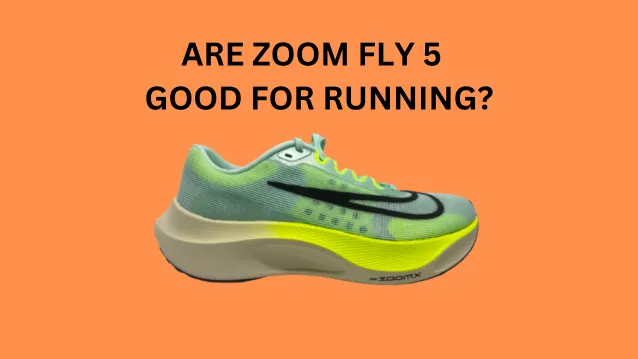The Nike Zoom Fly 5 is the latest iteration of Nike’s popular Zoom Fly running shoe line. As a relatively new shoe model that was just released in 2022, runners may be wondering if the Zoom Fly 5 is a good option for their training and racing needs. In this article, we’ll take an in-depth look at the Zoom Fly 5’s features, pros and cons, and overall performance for running.
Outsole and Midsole Technology
The outsole of the Zoom Fly 5 uses Nike’s lightweight and durable rubber with traction pads in the forefoot and heel for grip on various surfaces. The midsole utilizes Nike’s responsive React foam along with a wide Zoom Air unit in the forefoot to provide a smooth and energetic ride.
The Zoom Air pod is wider than previous versions to promote stability. There is a carbon fiber plate that runs the length of the shoe for propulsion and energy return. Overall, the midsole and outsole are designed to optimize bounce, flexibility, and traction.
Weight and Fit
The Zoom Fly 5 weighs around 8.5oz for a men’s size 9, so it’s a relatively lightweight yet cushioned shoe. The upper uses an engineered mesh material that aims to provide a secure midfoot lockdown and breathable coverage.
The fit is snug in the midfoot but allows some roominess in the toe box for toe splay. The Zoom Fly 5 comes in standard D/medium widths for men and B/medium widths for women. Overall, it offers a performance-oriented fit that is designed to lock the foot in place.
Performance and Feel
Testers note that the Zoom Fly 5 feels light and fast underfoot. The React foam and Zoom Air unit provide softness for impact absorption while also feeling responsive.
The carbon plate delivers good energy return for propulsion through the gait cycle. The traction pads offer grip on roads and sidewalks. For longer runs, the React foam maintains cushioning and bounce mile after mile. It’s a good balance of comfort and speed.
The Zoom Fly 5 works well for different types of runs and paces – from slower jogs to tempo miles and fartleks. The shoe excels at uptempo running and faster workouts such as speed intervals on the track or treadmill. It’s responsive with each foot strike but also offers protection from impact forces.
Some testers note the Zoom Fly 5 runs slightly long due to the pointy toe-box shape. Trying them on before purchasing is recommended. Also, the React foam may feel too firm for some – runners who prefer a softer feel may want to look at models with ZoomX foam.
Durability
The Zoom Fly 5’s outsole rubber provides good durability for high-mileage runners. The React foam maintains its energetic bounce and springiness over time without excessive packing out or flattening.
Nike also reinforced the upper with an extra layer of material in high-wear zones for added longevity. In general, most runners can expect around 300-500 miles of use before signs of significant midsole or outsole wear in the Zoom Fly 5. Rotating with a few pairs of running shoes helps extend their lifespan as well.
Pros
- Lightweight yet cushioned
- Low-to-the-ground feel for speed
- Zoom Air unit provides responsive propulsion
- Durable outsole and midsole
- Breathable mesh upper
- Works for wide range of speeds and distances
Cons
- Runs slightly long due to toe shape
- Not as soft/plush as some competitors
- Expensive retail price
Conclusion
The Nike Zoom Fly 5 is a lightweight, responsive shoe that excels at everything from uptempo training runs to faster race days. The React foam and Zoom Air pod provide a good balance of softness and energy return for running.
Traction and lockdown are also reliable for variable speeds and distances. While not the softest option, the Zoom Fly 5 offers a durable and propulsive feel for neutral runners looking for tempo workout/race day shoe.
Similar Running Shoe FAQs
Here are answers to some frequently asked questions about finding the right running shoes:
How do I choose the right running shoes for me?
Consider your foot type, running gait, training goals, and typical running surfaces when choosing shoes. Visit a specialty running store for an in-person gait analysis to get matched with the best shoes for you. Or simply choose neutral cushioned shoes if you don’t overpronate. Trying on shoes to assess fit and feel is also important.
What features should I look for in running shoes?
Cushioning, flexibility, breathability, durability, and the right fit for your foot shape are key features. Your needs will vary based on your foot strike, mileage, gait, and running surfaces. Prioritize cushioning and support if you run long distances on hard surfaces. Or look for sticky rubber outsoles if you run trails.
How do I know when to replace my running shoes?
Replace your running shoes about every 300-500 miles to avoid injury risk from excessive wear. Signs that your shoes need replacing include the outsole wearing thin, creasing/wrinkles in the midsole, less bounce and cushioning, and the fit becoming loose and sloppy. Rotating 2-3 pairs helps maximize longevity.
Should I purchase my trail running shoes a half or full size up?
It’s often recommended to purchase trail running shoes a half or full size up from your road running shoe size. This provides a little extra room for your feet to splay naturally on uneven terrain and downhill grades. Wearing thicker trail socks can also impact sizing. Just don’t size up so much that your foot is sliding around in the shoe.
What type of shoes are best for treadmill running?
Cushioned road running shoes work well for treadmill running. The consistent man-made surface allows you to maximize cushioning and energy return without necessarily needing deep lugs or trail-specific features. Focus on shoes that fit your foot shape and gait needs.


